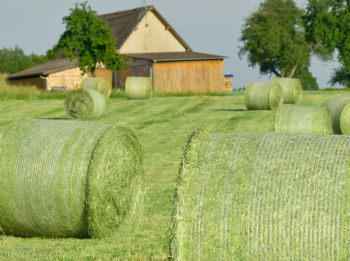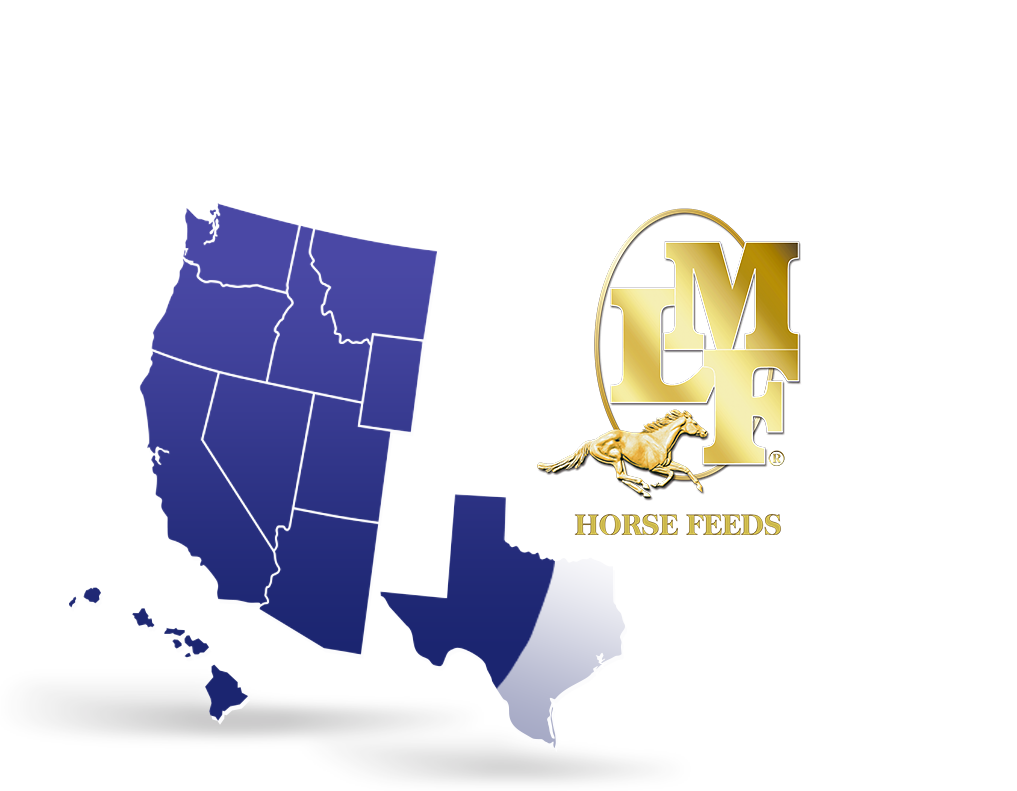Selecting Forage for Horses
Forage, such as hay and pasture is critical for the health and well-being of all horses. Knowledge of what’s in forage, the types and physical forms of forage and importance of forage quality should be common for all horse owners.
Forage Type:
Forage in the form of hay or pasture is the primary ingredient in the diet for most horses. Horses can consume many different varieties of high quality forage, both alfalfa and grasses, without out digestive upset provided the horse is properly adapted to the forage.
There are many plants that can be grown, cut and stored for use as horse forage. From a practical standpoint forages can be roughly divided into legumes and grasses. Legumes commonly include alfalfa and clover. Grasses consist of many varieties including: timothy grass, orchard grass, rye grass, bermuda grass, teff grass, blue grass, fescue and many others. Misconception: Horses can’t eat “pick a variety” forage. I have personally heard that horses can’t eat alfalfa, clover, fescue, bermuda grass as well as others varieties. Fact: If forage is properly cut, harvested and stored horses can eat many varieties of forage. Unless, the horse has a specific allergy or health condition many different forage choices will suffice. Solution: Many horse owners choose forage based on what is familiar to them. Then these people move to a different area of the country that raises different varieties of forage. Rather than condemn a forage as evil, talk with your veterinarian or nutritionist to make an informed decision.
Forage Cutting:
Depending on climate conditions, length of growing season and the variety of forage it is possible to have as few as one cutting or as many as seven cuttings in a season. Misconception: Horses can only eat first cutting forage, or horses can only eat third cutting forage. Fact: The quality or the suitability of forage for horses is not determined by the “cutting” but instead is determined by the height of the plant at the time of cutting. The taller a plant becomes, the more of its structure is dedicated to supporting the plant to keep it upright. This means as plants become taller they become more fibrous, like trees, and less digestible. Taller plants will contain less energy, less protein and be less digestible compared to shorter plants. Solution: So selecting forage should be based on the height of the plant at the time of harvest rather than it is first or second cutting. For example, it rain delays the harvest of a cutting of forage, it will become taller and less digestible which may cause it to be low quality for horses.
Dust/Mold/Foreign Material:
Dust in forage can originate from dirt acquired in the harvesting process or it actually may be spores from mold. Foreign material in forage is loosely defined as anything that can’t outrun the baler and may include: paper, plastic, aluminum cans, dead rodents or snakes. Misconception: I have heard many times that horses are too smart to eat dust, mold or foreign material. Fact: Unfortunately, horses will consume dusty or moldy forage, particularly if they don’t have a choice. They will also eat paper or plastic due to boredom. They also have been known to accidently consume hay contaminated with dead animals. Horses can become sick, injured or even die from eating these materials. Solution: We are responsible for selecting forage for horses that is free of dust/mold and foreign material. We should always carefully inspect the forage at the time of purchase, but also re-inspect the forage as it is being fed to ensure the hay in not contaminated.
Storage Form:
Forage can be stored in many different physical forms. The most common forms include: small rectangle bales (2-string), large rectangle bales (3-string), larger rectangle (5-string) and round bales. Misconception: Horses should never eat forage stored in round bales. Fact: The physical storage form of forage does not influence its nutrient content or digestibility. Forage that is harvested at the proper stage of maturity and allowed to dry to the proper moisture content can be fed to horses regardless of the storage form. Forage that is put into a bale when the plant is too wet will mold regardless of the type of bale. Further, forage that is put into a bale at the proper moisture content but then stored outside without cover will mold and become weather damaged independent of the bale type. Solution: Regardless of the type of bale, make sure forage was properly dried prior to baling and store bales in a covered area to prevent future weather damage.
Physical Form:
Forage can be processed into a number of physical forms to enhance ease of storage or feeding convenience. Common physical forms include: pellets, cubes and chopped (chaff) products. Misconception: Horses will choke on forage pellets or cubes. Fact: Horses, as well as humans, can choke on any food or feed that is not properly chewed prior to swallowing. Horses can be fed forage in many different physical forms without problems, as long as the rate of intake is monitored. Further, the processing of the forage will not increase or decrease the digestibility of the forage, and it will not influence digestive function. Solution: The physical form of forage should not prevent you from buying a certain variety of forage. Horses can eat many different physical forms of forage without digestive problems. Regardless of the physical form of forage, all horses should be gradually adjusted to any change in physical form.
Rained On Forage:
Plants that are being grown and harvested for stored forage for horses may get rained on once the plant is cut. Misconception: Forage that has been rained on is not suitable for horses. Fact: Forage that has been rained on after cutting will need to stay in the field longer to adequately dry prior to baling. As long as the forage is at the proper moisture content prior to baling the forage can be fed to horses. The longer forage must lay in a field to dry, the more potential for nutrient loss, so multiple rain showers can be a problem. Solution: Horse owners do not need to shy away from rained on forage as long as the hay was properly dried prior to baling and as long as the rain shower did not significantly extend the time the forage had to lie in the field.
Sugar Content of Forage:
Many horse owners have animals that are sensitive to the sugar content of forage due to diseases such as insulin resistance and laminitis. Misconception: Alfalfa is high in sugar and is not appropriate for horses that are sugar-sensitive. Fact: Alfalfa is actually lower in sugar than many types of grass hay as sugar is not the primary energy storage unit of legumes. The sugar content of hay is determined by many factors including variety of forage, growing conditions and harvesting conditions. Cool-season grasses store carbohydrate as sugar and are naturally high in sugar. Solution: If your horse is sensitive to the sugar content of the diet, all forage should be tested for sugar content prior to feeding any variety. Simply believing that one type of forage is better than another is not the answer.

Available Across the West.
Distributed throughout the Northwest, Southwest, Hawaii and Texas.
Find a Dealer Near You
